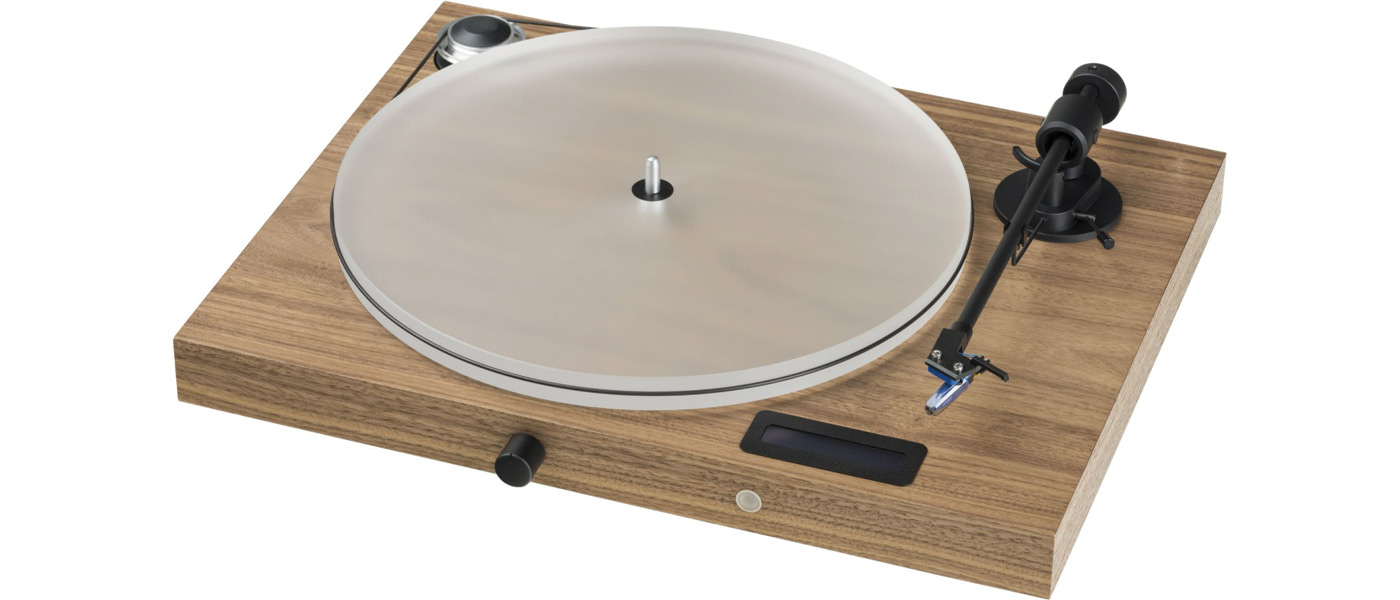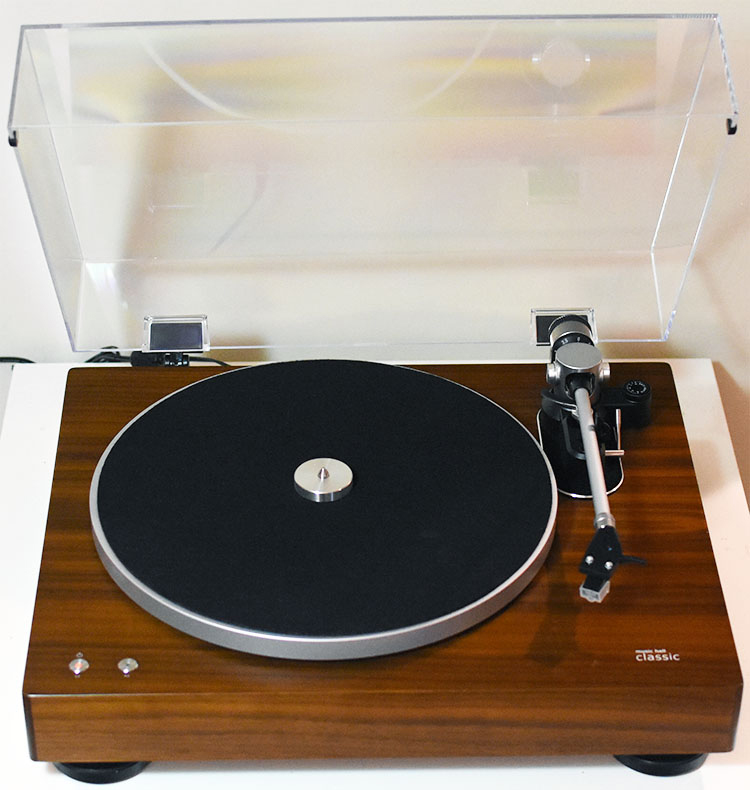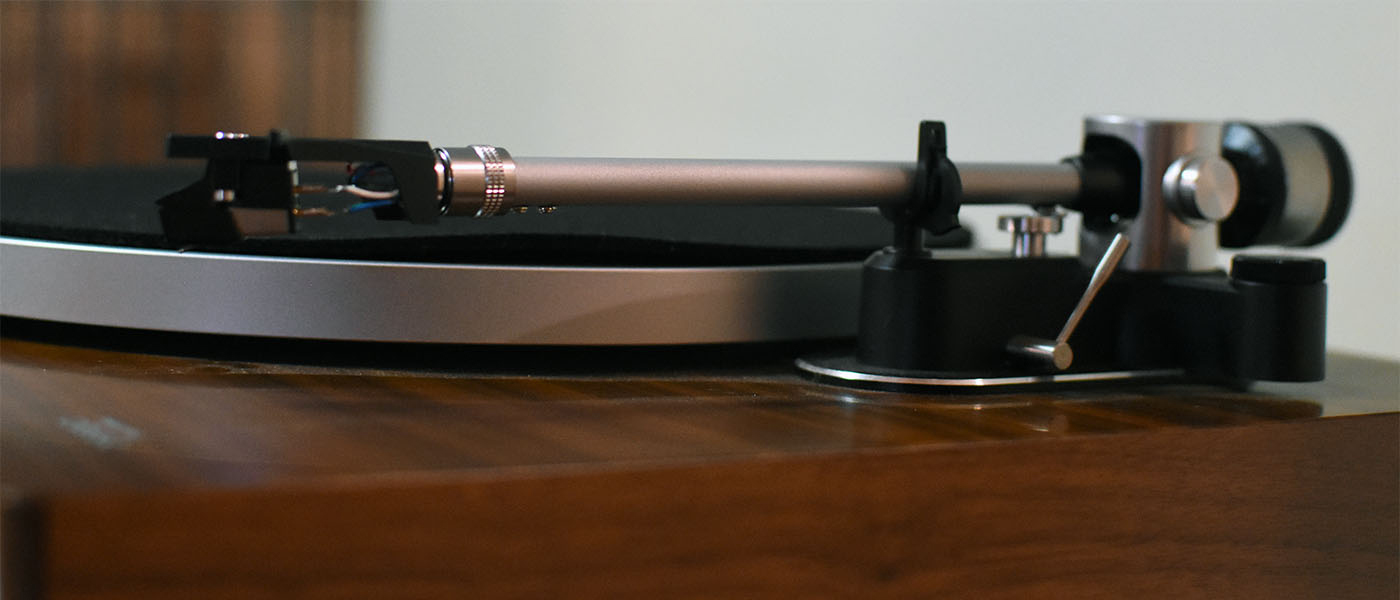
Music Hall Classic tonearm
Not only does the Classic turntable looks good, but it is also equipped with desirable features, such as electronic touch-sensitive speed control and auto-stop/auto-lift function. It also has a built-in phono stage (defeatable) and hence, it can be directly connected to the regular line-level input of any preamplifier or integrated amplifier. This feature makes it easy for people to jump on the vinyl bandwagon if they were not into vinyl before. The Classic turntable is shipped with Music Hall’s own Spirit cartridge and is ready to play vinyl right out of the box. The review below will touch more on the features as well as the performance of this turntable.
Music Hall Classic Turntable
- Simple yet classy-looking two-speed belt-driven turntable.
- Touch-sensitive speed-selector buttons.
- Built-in phono-stage preamplifier.
- Auto-lift/auto-stop mechanism.
- Good build quality and finish.
Vinyl technology has been around for over a century and the vinyl media has assumed its current commercial Long-Playing (LP) form since 1948. The format quickly garnered popularity, but with the rise of digital audio technology, it experienced what seemed like a slow death during the 1990s and 2000s. In recent years, however, vinyl has experienced a strong revival. Based on the current popular trend, it is quite clear that vinyl is here to stay, at least for the foreseeable future. Notwithstanding its limitations, the format certainly possesses undeniable appeal and is touted as the de facto analog audiophile format in the audio community.
Most audio enthusiasts who, like me, began their audio journey towards the end of the last century or early in this millennium, usually did not start with vinyl. Compact Disc (CD) or cassette tape (remember that?) is the most likely starting point. With the rising popularity of vinyl, I am sure that a good number of non-vinyl audio enthusiasts consider joining the vinyl bandwagon, although the thought about the amount of investment needed to get to it can be overwhelming. Understandably, one needs to get a good turntable as a starter for vinyl playback. Typically, though, a turntable is not the only component needed to build a good vinyl playback system. One also needs to add a good phono-stage preamplifier, which is often not part of their existing system. This can become a hindrance in building a vinyl playback system.
Secrets Sponsor
Roy Hall, the man behind the Music Hall audio company, seems to understand this issue. Several turntable models from the company’s product lineup are equipped with a built-in phono-stage preamplifier. As such, these turntables accommodate easy adoption into one’s audio rig by allowing their signal outputs to be connected to any device accepting line-level inputs. The Classic turntable reviewed here is one such product. And for a modest price tag of $599, it is also equipped with touch-sensitive speed-selector buttons and auto-lift/auto-stop features, which make the turntable easy to operate. Let us look more in-depth into this very appealing turntable.
Type:
2-speed semi-automatic
Motor:
DC motor
Driving method:
belt drive
Turntable platter:
12 in (305 mm) diameter aluminum die-cast
Speeds:
33 1/3 and 45 rpm
Wow and Flutter:
Typical: less than 0.12% WTD at 3KHz RMS(CD-4005)
Limit: Less than 0.15% WTD at 3KHz RMS(CD-4005)
S/N ratio:
Typical: More than 65dB (DIN-B)
Limit: More than 62dB (DIN-B)
Speed Tolerance:
3000Hz +/-3%(CD-4005)
Power supply:
DC12V,2.0A universal power supply
Dimensions:
17.1(W) x 14.5(D) x 6.2(H) in.
435(W) x 367(D) x 157(H) mm
Weight:
15.2lbs. / 6.9Kg
MSRP:
$599
Spirit cartridge (included with the Music Hall Classic turntable) technical data:
Frequency response:
20Hz – 20kHz ± 3dB
Channel balance:
2.5dB @ 1kHz
Channel separation:
>20dB @ 1kHz
Output:
3.5mV ± 2dB, 1kHz @ 5cm/sec
Vertical tracking angle:
20 degrees
Stylus shape and type:
elliptical 0.4 x 0.7 mil, replaceable
Stylus construction:
bonded round shank
Load impedance:
47,000 Ohm
Cartridge weight:
5.7g
Playing weight:
1.5 – 2.5g (2.0g nom.)
Website:
Company Directory:
SECRETS Tags:
Music Hall Classic turntable, Music Hall, classic, turntable, turntable review, review 2021
The Music Hall Classic turntable comes well packed with all its components nicely secured among the fitted paddings inside the box. Typical to turntables, some assembly is required prior to use. For the Classic, this assembling process, which involves installing the platter, inserting the headshell with a pre-mounted cartridge into the tonearm, adjusting the counterweight of the tonearm, and installing the dust cover onto the table, is a relatively straightforward undertaking and the steps are described well in its manual. Setting up the arm is particularly easy as music Hall has etched a line on the back of the tonearm to show the correct position of the counterweight. 15-30 minutes is all it takes to complete the assembly.
The Classic is a two-speed (33.3 RPM and 45 RPM) belt-driven turntable. The rubber belt to drive the table is nicely tucked under the aluminum platter during shipping and just needs to be connected to the motor spindle during assembly. The selection of the motor speed is done through two touch-sensitive buttons on the front-left top-side of the table. There is a small LED indicator in the middle of each speed-selector button, which will illuminate blue when the turntable is operating at the selected speed. The inclusion of the touch-sensitive buttons on the turntable is a nice touch and gives a modern feel to this classic equipment.
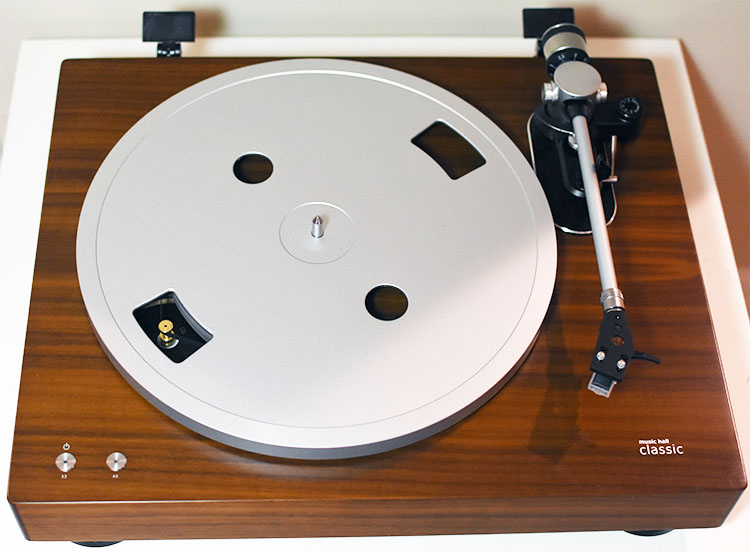
Music Hall Classic top view of main components
The Classic turntable has a uni-pivot tonearm with a removable headshell, which is shipped with the pre-mounted Music Hall Spirit MM cartridge. Hence, the turntable comes with everything needed for extracting signals from vinyl. The removable headshell also reduces the effort for changing or swapping cartridges. As previously mentioned, the Classic turntable is equipped with a built-in phono-stage preamplifier, which amplifies the phono-level (~5 mV) to line-level (~1-2 V) signals, allowing vinyl playback by just connecting the turntable output to the line-level input connector found on most audio preamplifiers, integrated amplifiers, or receivers. This feature is defeatable, so it does not hinder the use of an external phono preamplifier if preferred.
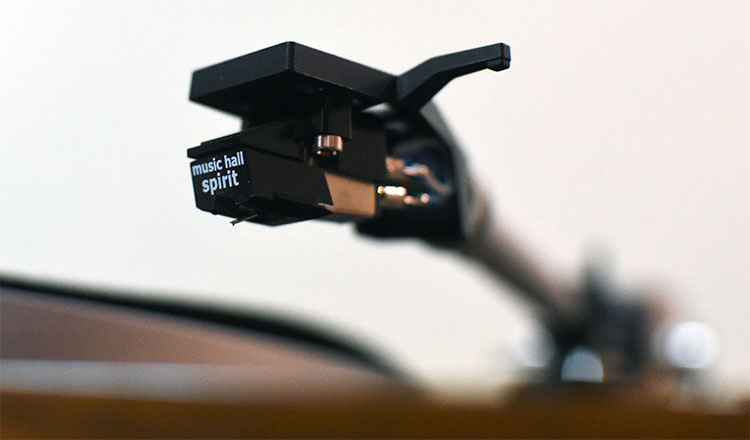
Music Hall Spirit cartridge
The Classic turntable is also equipped with an auto-lift/auto-stop mechanism. According to Roy Hall, creating a musical turntable with an auto-lift/auto-stop feature is one of the main motivations behind this product. In his observation, the auto-lift/auto-stop mechanisms employed by many turntables interfere with the playing of the vinyl, and thus negatively affect their playback performance. I do not have sufficient knowledge in this matter to confirm or deny Roy’s observation, but it is clear that the mechanism employed in the Classic turntable adheres to the principle of avoiding playback interference. This auto-lift/auto-stop mechanism works in a stand-alone manner, separated from the rest of the turntable’s subsystems, and only comes alive when the stylus has reached the end of the grooves. It works by listening to the lack of sound in the lead-out groove of the vinyl and once it has determined no more music is to be played, the piston part of the mechanism is activated by a small motor to lift the arm.
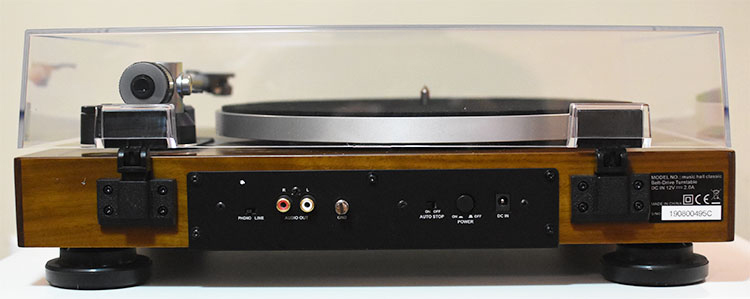
Music Hall Classic TT rear connectors
The turntable requires DC power for its operation and is supplied with a 12V, 2A power adapter. The DC power input jack of the turntable is located on the rear panel, together with the main power button, auto-stop on-off switch, single-ended audio output connectors, ground connector, and phono-stage on-off switch. The presence of the auto-stop on-off switch indicates that the auto-lift/auto-stop mechanism can be defeated if desired. A clear plastic dust cover, attached using the inserted plastic hinges to the back of the table, is also included with the Classic turntable.
Overall, the Music Hall Classic turntable exhibits the appearance of a fine classic turntable with a thick-looking plinth and silver-color platter/tonearm. The MDF plinth of the turntable feels sturdy and handsomely finished in a smooth dark walnut wood veneer. The four large adjustable damping feet, which are made of plastic, provide an overall stable foundation for the table. The build quality is very good, and, in my opinion, the turntable overall looks classy.
For this review, I paired the Classic turntable with the Michi X3 integrated amplifier driving the Revel Ultima Studio speakers. I tried both line-level and phono-level connections to the X3, to get a feel of the built-in phono-stage performance of the turntable. I also used the Rega Planar 1 (P1) turntable (MSRP $475), which is equipped with a stock Carbon MM cartridge, for comparison during the review.
A quick check using RPM Speed and Wow app installed on my Android phone revealed that the motor of the Classic was able to generate quite accurate and steady platter rotation. Its speed variations in both speed settings (33.3 and 45 RPM) were relatively low at around 0.2%. I like the fact that I could change the speed rapidly using its touch button selectors. This is unlike the Planar 1 where, to change speed, I need to lift the platter and adjust the rubber belt track. The Classic is just plainly more convenient operationally in this regard.
Secrets Sponsor
The auto-lift/auto-stop feature worked well most of the time, although on some rare occasions it took a while to detect that it had reached the end of the record. This can happen, for example, if the end of the grooves produces noise that might be confused with the presence of the musical signal. With this feature, I did not need to rush to stop the turntable when it had finished playing a record side or when I needed to step out for a short while from my listening area. The presence of this feature gave me extra peace of mind knowing that the stylus would not graze the vinyl surface unnecessarily at the end of playback.
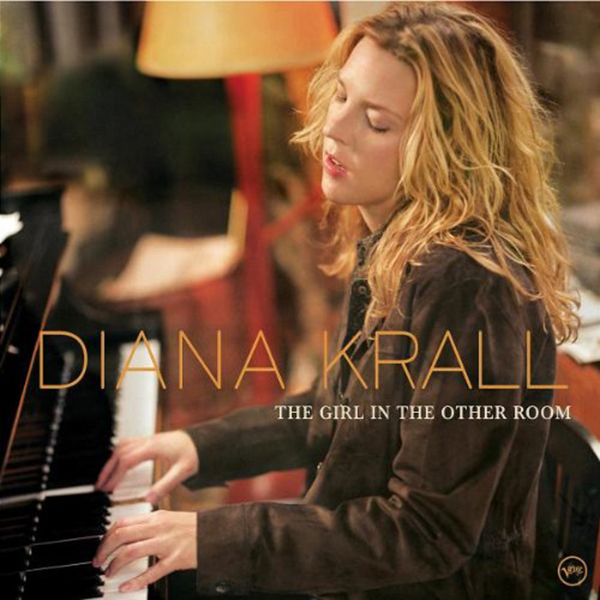
Diana Krall’s The Girl in the Other Room (2004) album cover
The Girl In The Other Room, Diana Krall, (2004)
I started my listening of the Classic turntable by using its line-level output, utilizing its built-in phono stage preamplifier. Operational convenience aside, listening to vinyl through the Classic turntable was a delightful experience. The sonic characteristics of the Classic carried a strong sense of musicality in its presentation. Musical notes during playback sounded steady yet relaxed and free from sharp-edged artifacts. The Classic effortlessly drew me into its musical presentation and made me want to listen more.
Diana Krall’s The Girl In The Other Room (2004) LP exemplifies my various points above. I have listened to the tracks in this very well-recorded album in various formats and on various systems, hence I have viable comparison references to form a proper impression. Played through the Classic, Diana Krall’s voice sounded natural and full-bodied as exemplified especially in the title track The Girl In the Other Room. The rhythm and pace of the track Temptation from the same album were conveyed nicely in a believable, intimate soundstage. Transparency, details, and dynamics were all good, although they were a tad lacking compared to what I am accustomed to when listening through my digital playback system. To put it in proper perspective, though, this was not a fair comparison as the digital part of my system used in this comparison, which consisted of PS Audio PerfectWave Transport and PerfectWave DAC II, cost many times more than the Classic. Moreover, the Classic’s very involving and musically satisfying presentation more than made up these slight deficiencies, which were only noticeable in direct comparison.
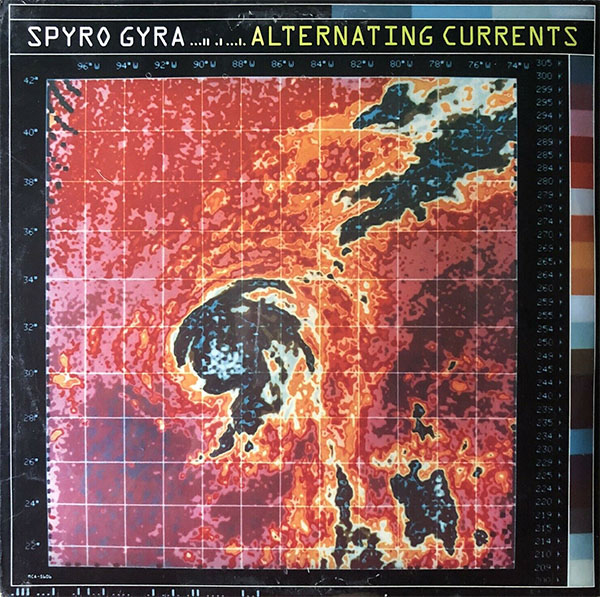
Spyro Gyra’s Alternating Currents (1985) album cover
Alternating Currents, Spyro Gyra, (1985)
The sonic balance of the Classic across the frequency spectrum was particularly good as exhibited in playing a rather old Alternating Currents (1985) LP by the contemporary jazz group Spyro Gyra. This recording is rather lean in the bass and might sound a bit thin in a lesser system. However, played back using the Classic turntable, except for the bass leanness, it was actually quite pleasant to listen to and did not sound thin at all. It did not prevent me from toe-tapping as the pace and rhythm of the music were conveyed nicely by the Classic.
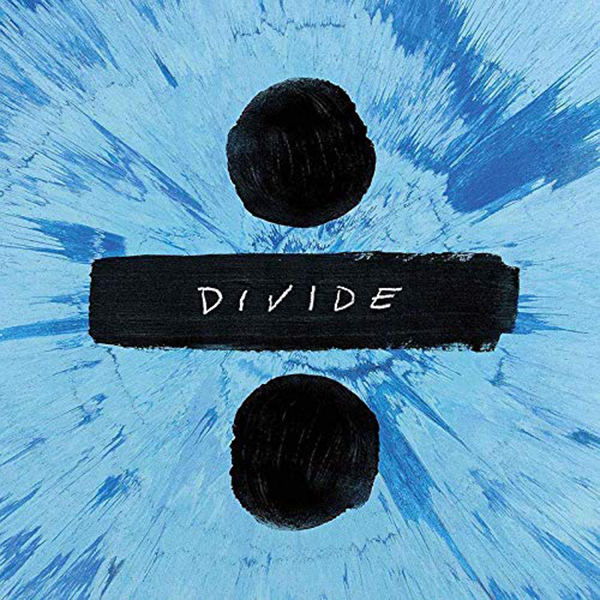
Ed Sheeran’s Divide (2017) album cover
Divide, Ed Sheeran, (2017)
Most of the vinyl I tried during the review was of the 33.3-RPM variety. But the Classic turntable performed equally well in playing 45’s, as with the Ed Sheeran’s Divide LP (2017). The chorus of the track Hearts Don’t Break Around Here from this album sounded great through the Classic with the background vocals and all the instruments playing simultaneously. The Classic did an admirable job in conveying the separation among the various musical elements in the track.
At the later stage of the evaluation, I also tried connecting the Classic to the phono stage of the Rotel MICHI X3 which I found to be quite excellent. In my system, I slightly preferred the results from this pairing as compared to the playback results using the Classic’s built-in phono stage, as it produced slightly more focused images and a better portrayal of the musical textures, which led to the improved presentation of details and clearer separation among instruments. These differences were not night-and-day and might be system-dependent. This comparison also suggests that the built-in phono stage of the Classic is a competent one.
Out of curiosity I also compared the Classic to the Rega Planar 1, connected to the phono stage of the Michi X3. In my system, the Classic was the clear winner here. The Planar 1 is not a slouch by itself, but it has a slightly noisier background and lacks clarity in its presentation when compared to the Classic.
With its good looks and build quality, backed up by its wonderful sonic performance and features, the Music Hall Classic turntable brings a lot of bang for the buck with its $599 price tag.
- Classy-looking turntable with great build quality
- Touch-sensitive speed selectors
- Built-in phono preamp
- Auto-lift/auto-stop mechanism
- Very musical sonic performance
- None
The Music Hall Classic turntable has the look and features that can rival the more expensive ones out there. It is a well-built and attractive-looking turntable that is loaded with features such as touch-sensitive speed selector buttons, the auto-lift/auto-stop feature, and a built-in phono stage preamplifier. More importantly, the Classic backs up those desirable operational features with its strong vinyl-playback performance, producing highly musical sonic traits that brought me a delightful listening experience. With the combination of strong sonic performance and desirable features, the Music Hall Classic turntable is a product of significant value that is hard to beat in its price range.


